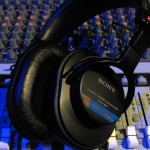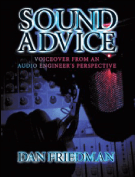 Recording Magazine sends out a newsletter to its subscribers every few weeks. The newsletter is (coincidentally) titled “Sound Advice” and this month it features a new series on headphones and monitors. I asked permission to reprint this newsletter (and will ask to reprint the others in the series as well) so that those of you with home studios can also benefit from the information. I want to personally thank Brent Heintz, VP/Associate Publisher for granting permission, allowing me to share this great information with you.
Recording Magazine sends out a newsletter to its subscribers every few weeks. The newsletter is (coincidentally) titled “Sound Advice” and this month it features a new series on headphones and monitors. I asked permission to reprint this newsletter (and will ask to reprint the others in the series as well) so that those of you with home studios can also benefit from the information. I want to personally thank Brent Heintz, VP/Associate Publisher for granting permission, allowing me to share this great information with you.
Please visit Recording Magazine‘s website and their Facebook Page.
Voiceover usually deals with a singular signal (your voice) and therefore it is typically mono. However, the importance of space and spatial recognition cannot be overstated. By their very nature, how you hear headphones and monitors greatly effects how you hear yourself and your ability to interpret what you hear.
So… please enjoy this installment from Recording Magazine’s Sound Advice on Acoustics.
Welcome back to Sound Advice on Acoustics! We’ve been discussing the question of whether headphones can serve as adequate replacements for studio monitors, and at the end of our last installment, author Robert Auld said the answer to that question is “Yes, but.” It’s time to find out what he means, starting with the “Yes” part…
***
There are many situations where headphones have the potential to offer a higher quality of sound than loudspeakers:
~ They are not dependent on room acoustics, which can vary tremendously. As a sound reference that is consistent from venue to venue, headphones are a uniquely practical solution.
~ Most practical high-quality loudspeakers use more than one driver for each channel and need a crossover network of some sort. The potential for sonic problems with this arrangement has always been a challenge for speaker designers. Headphones can bypass such problems entirely by using a single driver for each channel.
~ There is no agreement as to the ideal polar radiation pattern for a loudspeaker. A variety of approaches are found in both consumer and professional settings, and they all interact with the listening room in different ways. With headphones this is not even a consideration, let alone a problem.
~ The very characteristic that makes the most difference in the way headphones sound—the lack of interaural crosstalk—makes them revealing of details in a recording to a degree that no conventional loudspeaker setup can match. This is one reason why many classical music engineers use them: if you need to catch things like that smudged entrance in the second violins or a fluffed note by the bassoonist, headphones will tell you about it much quicker than loudspeakers will.
~This same precision in rendering detail makes headphones superior for editing stereo program material. They reveal what is really going on at the splice point much more readily than loudspeakers—most of the time. (I’ll let Jerry Bruck tell you about the exceptions in a future installment of this newsletter.)
There are many practical advantages to using headphones as well:
~ They are lightweight and portable.
~ Dynamic-element phones have no need for large, powerful, expensive amplifiers. Suitable headphone amps are already built into a lot of recording equipment, and separate headphone amps are usually small and cheap compared to speaker amplifiers.
~ Closed-back headphones provide some isolation from your surroundings, making it possible to monitor where it would otherwise be difficult or impossible.
~ Some headphones are capable of deep bass response normally found only in very large full-range loudspeakers or in subwoofers. If you record pipe organs for a living—or, which is a lot more likely in this day and age, you record dance music or other bass-heavy musical genres like hip hop—you may find this useful.
~ Did I mention that they are lightweight and portable?
Even the more expensive top quality headphones offer more “bang for the buck” than loudspeakers. For example, the Sennheiser HD 580 has a street price of about $250. This gets you dynamic element headphones that are considered to be near-equivalent to the most esoteric electrostatic models. Loudspeakers with equivalent sonic performance could easily cost five times as much, or more.
But if it was really that easy, all the time, for everyone, there wouldn’t be loudspeakers in professional studios any more, would there? Tune in next time, when I reveal a subtle, annoying, even fatal fly in the ointment that more than adequately explains why even the smallest budget studio must have speakers as well as headphones. See you then.



